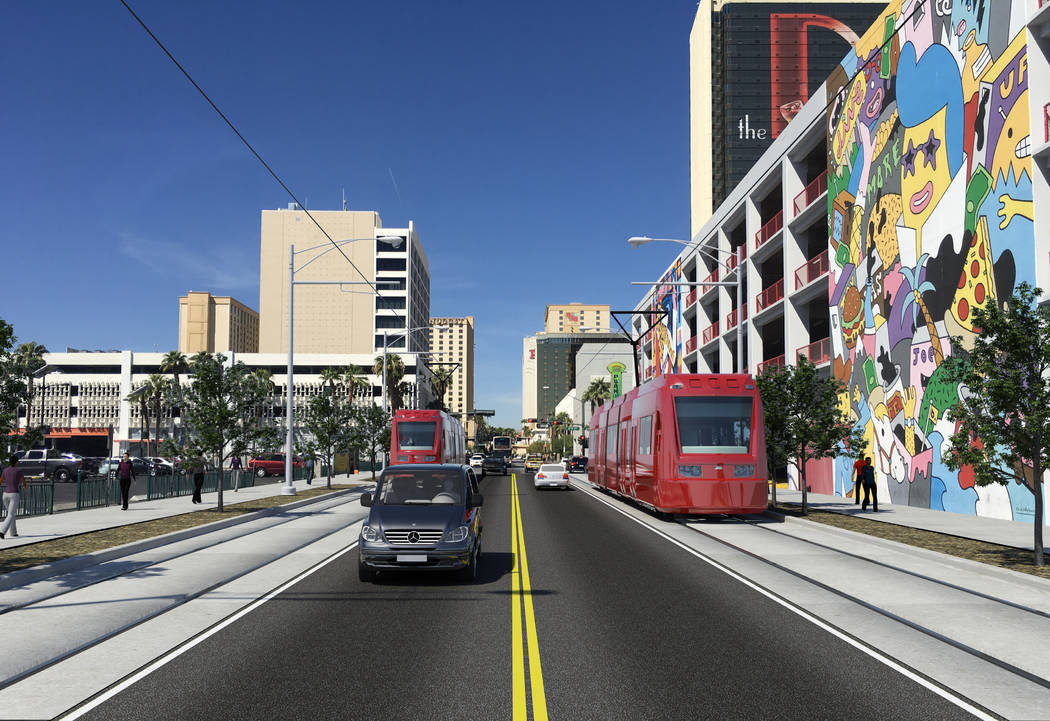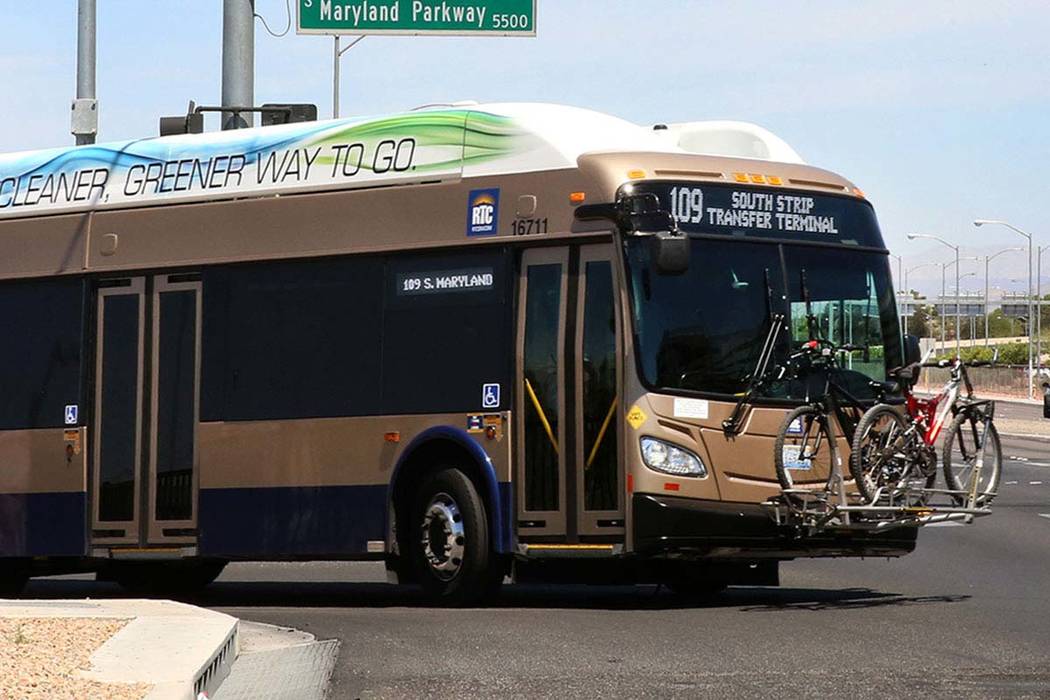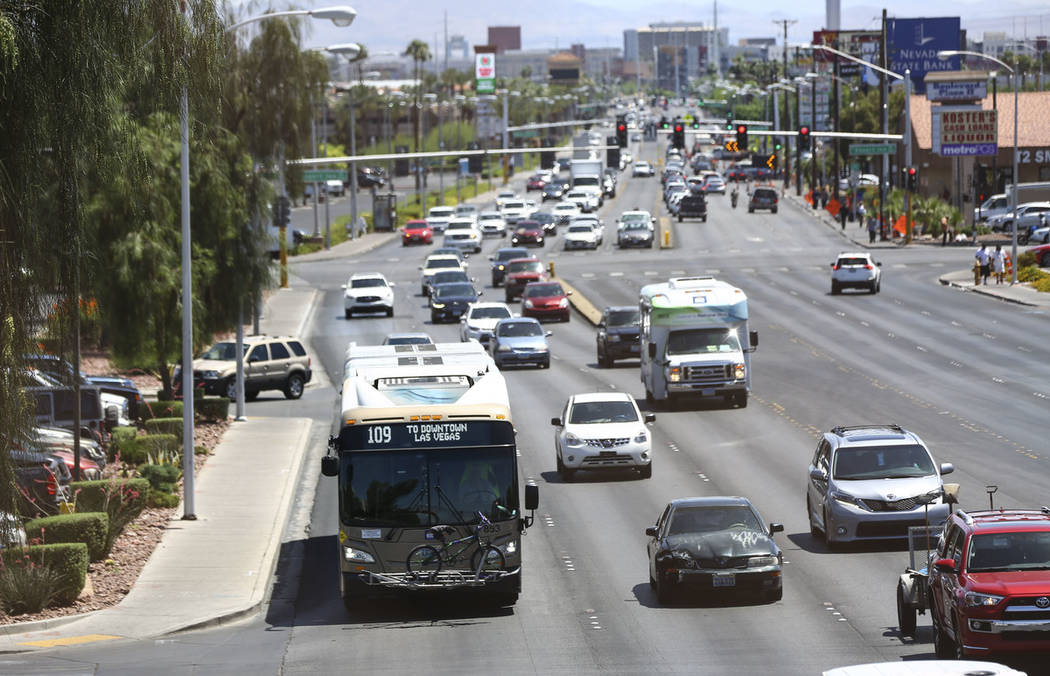Las Vegas transit officials set to make decision on light rail
Las Vegas’ transportation future could be steered in a new direction Thursday as local transit officials are set to decide if light rail is the right fit for the valley.
The Regional Transportation Commission of Southern Nevada hosted a series of public meetings and held an open call for public input on the future of the Maryland Parkway corridor last month. The results of that initiative and the commission’s preferred choice among three options are set to be revealed at the RTC’s board meeting Thursday.
Aside from light rail, a bus rapid transit system — a system featuring dedicated bus lanes that could be used as turn lanes when buses are not present — or enhancing the current bus Route 109 are being considered for an 8.7-mile stretch of Maryland Parkway.
The route under review stretches from near the airport to a portion of downtown Las Vegas and eventually ends up at the Las Vegas Medical District. The route would link UNLV, several hospitals and medical centers, commercial and residential complexes.
The RTC estimates more than 9,000 bus riders and 35,000 vehicles travel on Maryland Parkway daily.
The three options vary widely in possible costs. The light rail plan could cost as much as $750 million, while the bus rapid-transit plan could cost up to $335 million and the upgrading of Route 109 is estimated to cost about $29 million, according to the RTC.
Funding for whichever project is chosen has yet to be identified, but a combination of federal grant money and a possible sales tax increase could be used to pay for the preferred choice.
After the preferred mode is chosen, the RTC will submit the choice to the Federal Transit Administration this summer and then seek funding for the project.
As local transportation officials consider adding light rail to the Las Vegas transportation landscape, other similar projects have been stopped in their tracks across the United States.
Many communities are either scrapping plans for new rail projects or putting the brakes on expansion projects for varying reasons.
Orange County, N.C.
Last week, commissioners on the Orange County Board of Commissioners in North Carolina voted to end the development of a light rail system after various issues persisted.
In a unanimous vote, commissioners halted work on the project, yanking the earmarked $149.5 million in public funding along with it. They will focus on an alternative transportation solution for the area, according to Chapelboro.com.
The project would have featured a 17.1-mile track providing over 26,000 trips per day for commuters in Durham and Chapel Hill, according to the Go Triangle project’s website. Similar to the proposed Maryland Parkway line, the Go Triangle line would have linked higher education facilities, medical facilities and more.
In 2011 and 2012, voters in both Durham and Orange counties approved a half-cent sales tax to go toward the investment in enhanced transit service. Federal funding of approximately $1.25 billion was said to be expected and up to $190 million in state funding, according to Go Triangle.
Commissioner Mark Marcoplos, who is the county’s representative on the GoTriangle board, pointed out issues with “disingenuous” project partners Duke University and North Carolina Railroads, problems in the state legislature, and the partial federal government shutdown, which delayed the project by two months, Chapelboro.com reported.
Nashville
Last May, Nashville voted down a proposal that would have raised taxes to go toward transit projects, including a light rail system, according to The Tennessean newspaper.
The proposed $5.2 billion transit plan would have been headlined by a $828 million light rail system that would have stretched from Nashville International Airport to downtown.
One of the opponents of light rail in Nashville, Malcolm Getz, who recently retired as an economics professor after 45 years of teaching at Vanderbilt University, said that with everything factored in, improved bus service is the way to go because of its flexibility.
“The advantage of a bus-oriented service is buses can start beyond where the restricted lanes are and gather people in residential areas and use restricted lanes and go downtown,” Getz said. “With a railroad, people have to transfer between the bus and a rail, and transfers typically take 7-10 minutes and are a high annoyance to transit riders.”
The possibility of gentrification also should be considered, Getz said, because light rail has proven to spur economic development in areas surrounding rail lines, which can drive up property values and lead to lower-income residents being forced out of the area because of increased rent.
“People are riding this in an intensive way, leading to real estate development around the stops,” he said. “Most of our (Nashville’s) African-American community voted strongly no (on the referendum vote) because we’ve experienced gentrification and we’ve seen neighborhoods where property values are increasing and owner income communities are pushed out.”
Despite the vote against the transit system, Nashville Mayor David Briley is considering bringing up the light rail system again ahead of election season, WKNR.com reported.
The mayor’s office said Briley isn’t pushing a plan but is getting the ball rolling again to find an improved way to get in and out of the airport and to and from downtown Nashville, according to WKNR.com.
Phoenix
While several cities are scrapping plans for light rail implementation, one city is moving ahead with its light rail expansion, despite resistance.
The Valley Metro Rail Phoenix is set to unveil a new light rail station April 25. A 2.5-mile extension that pushes the 26.3-mile system farther east opens May 18, according to Susan Tierney, Valley Metro spokeswoman.
Approximately 50,000 people ride the light rail system each day, according to Valley Metro’s website. Those riders save about 15 minutes travel time on average during rush hour, the transportation entity said.
Valley Metro reported that since 2008, 35,000 jobs have been created within a half-mile of the light rail. The light rail system cost $1.4 billion to construct, according to AZ Central.
In addition to the pending additions in the coming month, work on the South Central and Northwest Phoenix II light rail extensions, as well as Tempe Streetcar, continue, Tierney said.
Contact Mick Akers at makers@reviewjournal.com or 702-387-2920. Follow @mickakers on Twitter.

























